The Cassoeula is much more than just a recipe: it is a symbol of Lombard culinary tradition, a dish that evokes warmth, conviviality, and the authentic taste of peasant cuisine. Originally from the Milanese area and Brianza, the cassoeula is a triumph of flavors and textures, where the sweetness of the cabbage blends with the richness of pork, in an irresistible combination.
Born from peasant culture, where nothing was wasted, the cassoeula represents the ingenuity and ability to use every part of the pig, even the less noble ones. Feet, tail, ears, rind: “poor” ingredients that, skillfully cooked, transform into a rich and tasty dish capable of warming the body and spirit on cold winter days.
This dish, a symbol of an era when saving was a necessity, reminds us of the importance of not wasting food and valuing every ingredient. Once, in Lombard families, preparing cassoeula was a true ritual, a moment of sharing and celebration, where people gathered around the table to enjoy this exquisite dish, the fruit of work and passion.
Today I will guide you step by step in the preparation of this extraordinary dish, revealing all the tricks for a perfect cassoeula!

- Difficulty: Easy
- Cost: Very Affordable
- Rest time: 20 Minutes
- Preparation time: 50 Minutes
- Portions: 4
- Cooking methods: Boiling, Slow Cooking, Oven
- Cuisine: Italian
- Seasonality: Fall, Winter, Winter
Ingredients
- 3.3 lbs savoy cabbage
- 1.6 lbs pork ribs
- 7 oz pork loin
- 8 verzini sausages
- 5 oz pork rind
- 1 pork feet
- 1 pork ear
- 1 pork tail
- 1/2 pork muzzle
- 2 carrots
- 1 golden onion
- 1 stalk celery
- 5 cluster tomatoes (Ripe)
- 3.5 oz dry white wine
- 1 clove garlic
- 1 sprig rosemary
- 4 leaves bay leaf
- 3.5 oz extra virgin olive oil
- 1 pinch fine salt
- 1 pinch black pepper
- 3.5 oz fine salt
- 1 sprig rosemary
- to taste parsley
- to taste marjoram
- to taste garlic
Tools
- 1 Saucepan Vier
- 1 Pot Lagostina
- 2 Baking Trays Master Class
Steps
To prepare our cassoeula, let’s start with the cabbage. Remove the more damaged outer leaves and cut it in half, removing the core. Separate the leaves and divide them into two groups: the darker outer leaves and the lighter inner ones. In a pot of salted boiling water, blanch the outer leaves for 10 minutes, drain them, and set aside. Repeat the process with the inner leaves. Now set them aside separately because they will be used at different times during the cassoeula preparation.

Now let’s move on to the meat. From our trusted butcher, choose the cuts most suitable for the cassoeula: feet, tail, ear, muzzle, ribs, verzini, rind, and loin. Remember that the loin will be used later and should not be blanched now. Ask the butcher to cut the larger pieces, like the foot and tail, to facilitate cooking.
Put all the meat pieces, except for the loin, in a large pot with cold water and bring to a boil. Let it blanch for about ten minutes, then drain the meat and set aside. This step will help remove impurities and make the meat more tender.
And now let’s take care of the tomatoes! Take the ripe cluster tomatoes and immerse them in boiling water for a minute. This will make it easier to remove the skin. Drain the tomatoes, peel them, and dice them.
At this point, separate the tomato pulp from the liquid released along with the seeds. You can use a fine-mesh strainer to help. Keeping both the pulp and the vegetable water aside will provide two valuable ingredients for our cassoeula.
And now, let’s focus on the vegetable mix that will give flavor to our cassoeula! Take the onion, carrot, and celery and prepare them for slicing.
Peel the onion and slice it thinly. You can use your preferred technique, the important thing is that the slices are of uniform thickness for even cooking.
Move on to the carrot: peel it and slice it, or dice it if you prefer a finer mix.
Finally, take the celery and, after removing the outermost filaments, slice it thinly.
This vegetable mix, called soffritto, is the base of many Italian recipes and will give our cassoeula an irresistible aroma and flavor.
After preparing our vegetable mix, let’s move on to cooking! Choose a pan with high edges and a thick bottom, ideal for this type of preparation. Pour a drizzle of extra virgin olive oil and let it heat over low heat. Then add the onion, carrot, and celery and let them sauté for a few minutes, stirring occasionally. Also add the bay leaves to the sauté, so they release their aroma.
To prevent the vegetables from burning and to achieve a tender and flavorful sauté, add half a glass of water and let the vegetables stew over low heat. This step is crucial for the success of our cassoeula, so make sure not to let the cooking base dry out too much.
It’s time to add the meat to our sauté! In the pan with the stewed vegetables, add the feet, tail, muzzle, and ear that we previously blanched. Mix well and let the meat simmer for a few minutes over high heat. Then, deglaze with half a glass of white wine, letting the alcohol evaporate.
Now it’s time to add the outer cabbage leaves, the dark green ones, that we blanched earlier. You will notice that during cooking, these leaves will tend to dissolve. Don’t worry, that’s the purpose! This is the peculiarity of the cassoeula: the outer leaves, cooking for a long time with the meat, will melt and help create a thick and flavorful sauce. Gently mix, cover the pan with a lid, and let it cook over low heat for about an hour and a half. During cooking, occasionally check that the cooking base doesn’t dry out too much, and if needed, add a ladle of hot water.
While our cassoeula is slowly cooking over low heat, let’s prepare an ingredient that will give an extra touch of flavor to our dish: the aromatic salt!
Finely chop the rosemary, parsley, marjoram, and garlic. Mix the chopped aromatic herbs with fine salt, obtaining a fragrant and flavorful mix. You can store the aromatic salt in a glass jar with an airtight seal, ready to be used to season our cassoeula, but also for other meat or vegetable preparations.
And now that our aromatic salt is ready, let’s move on to cooking the ribs and loin!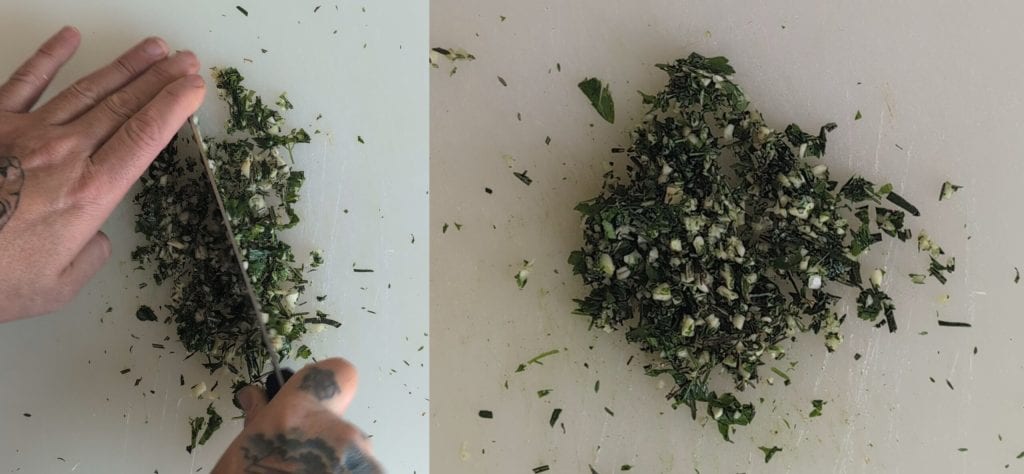
Now let’s take care of the ribs and loin, which will add an extra touch of flavor and texture to our cassoeula! Take two baking trays and place the ribs (previously blanched) in one and the loin in the other. Season both meats with a drizzle of extra virgin olive oil and our previously prepared aromatic salt. Massage the meat well so that it is seasoned evenly. The loin, being a leaner cut, doesn’t need to be blanched before cooking. Bake both trays in a static oven at 356°F for 15 minutes.

After an hour and a half of cooking, our cassoeula is starting to take shape! It’s time to add the rind, previously blanched, which will give the dish a gelatinous and flavorful consistency. Also add some of the inner cabbage leaves, the tender and light ones, and a portion of the diced tomato pulp that we had set aside. Gently mix to incorporate the new ingredients into the rest of the preparation, cover again with the lid, and continue cooking over low heat.
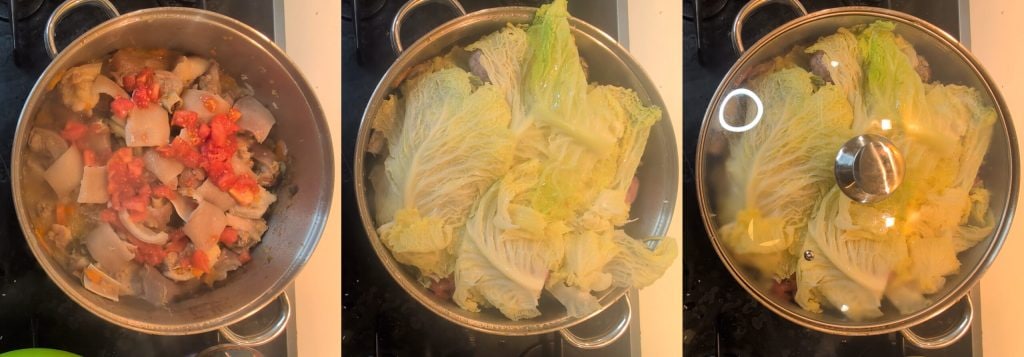
Ten minutes after adding the rind and mixing everything well, we can proceed with the final ingredients of our cassoeula! Take the ribs we baked in the oven and add them to the pan, making sure to remove the cooking base released in the tray. Also add the baked loin, a layer of diced tomatoes, and a pinch of aromatic salt. Cover with a layer of tender cabbage leaves, the inner ones we blanched at the beginning.
It’s time to add the verzini sausages, which will give the cassoeula an extra touch of flavor. Finish with the remaining tomato pulp and cover with all the remaining cabbage leaves. On the surface, add a few sprigs of fresh marjoram or another pinch of aromatic salt.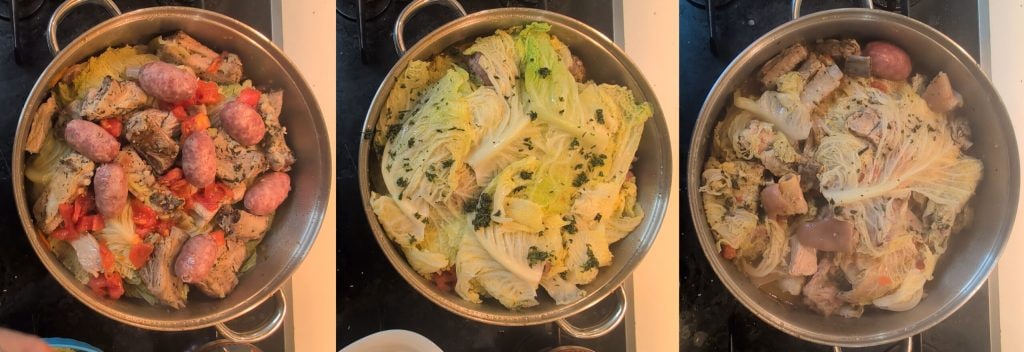
Now that our cassoeula is complete with all its ingredients, add the hot water needed for cooking. Pour it gently into the pan, being careful not to disturb the layers of meat and vegetables too much. Cover with the lid and let it cook over low heat for another 60 minutes. During this phase, refrain from stirring the cassoeula, so that the layers remain well defined and the cooking occurs evenly.
In the meantime, we can prepare the polenta, the perfect accompaniment to our cassoeula. Whether classic, taragna, or concia, polenta will perfectly complement the rich and intense flavor of our main dish.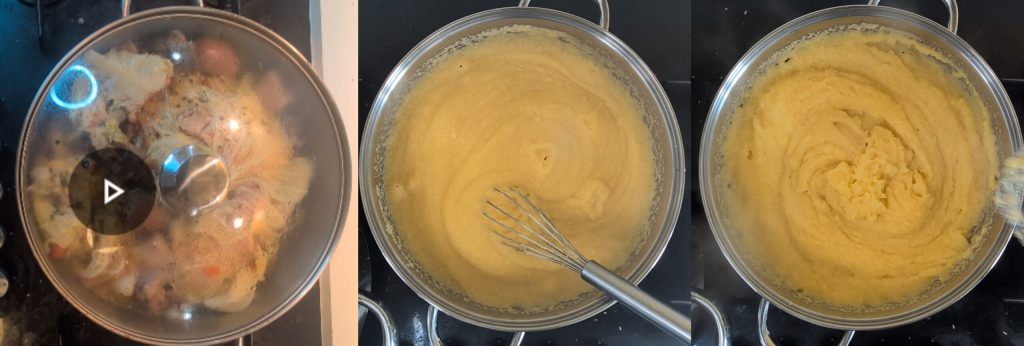
And after about 4 and a half hours of patient waiting, our cassoeula is finally ready! But before serving it, turn off the heat and let it rest for about twenty minutes. This will allow the flavors to further intensify, creating an even more harmonious and enveloping taste.
Open the pan and enjoy the intense and inviting aroma that is released. Serve the cassoeula hot in deep dishes, accompanied by a generous portion of steaming polenta. You can complete the dish with a drizzle of raw extra virgin olive oil and a grind of fresh black pepper.
The cassoeula is a unique, rich, and hearty dish, perfect for cold winter days. Enjoy it in good company, perhaps with a good glass of full-bodied red wine, and let yourself be conquered by its unique flavor and enveloping texture.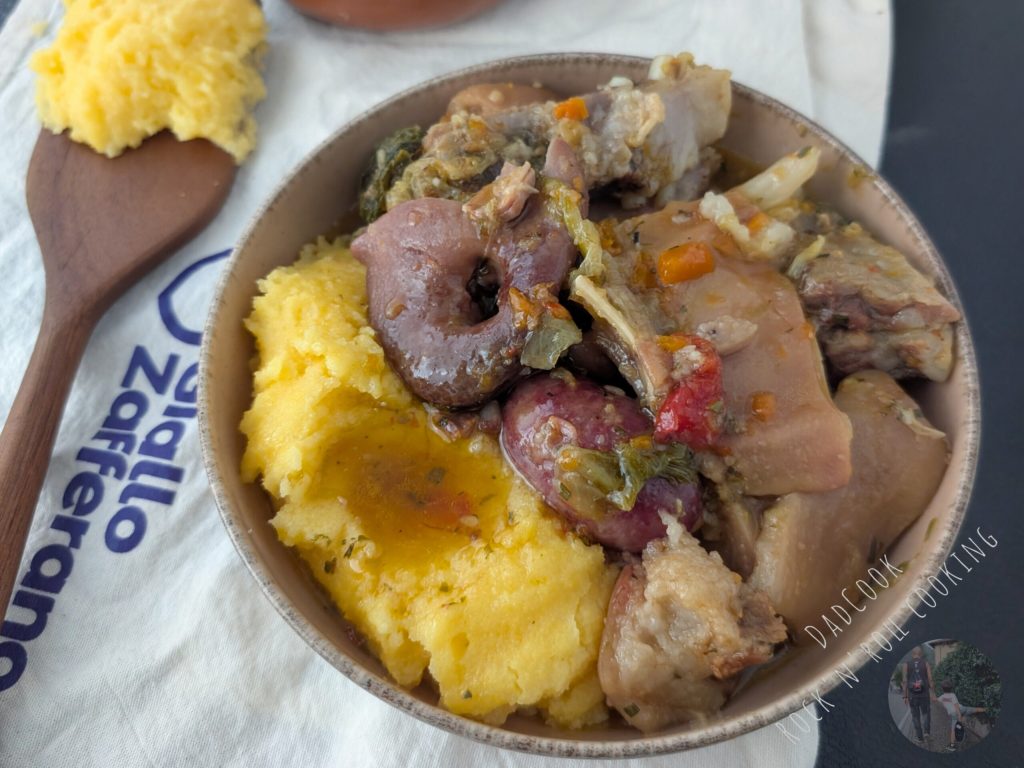
Tips for a Perfect Cassoeula:
The choice of cabbage:
For an authentic and flavorful cassoeula, use winter savoy cabbage, preferably after it has been frostbitten at least once. The low temperatures, in fact, favor the concentration of sugars in the leaves, making them more tender and sweet.
The quality of the meat:
Choose high-quality pork from your trusted butcher. The most suitable cuts for cassoeula are those rich in collagen, such as feet, tail, ear, and rind, which during cooking will release their gelatin, making the sauce thick and flavorful.
Slow cooking:
The cassoeula is a dish that requires long and low-heat cooking. This allows the meat to become tender and the vegetables to stew slowly, releasing all their flavors.
Resting:
Before serving the cassoeula, let it rest for at least 20 minutes. This way, the flavors will meld further, making the dish even tastier.
The accompaniment:
The cassoeula is traditionally enjoyed with polenta, which can be classic, taragna, or concia.
Pair with a good full-bodied red wine for a complete experience.
Pair with a good full-bodied red wine for a complete experience.
Storage:
The cassoeula can be stored in the refrigerator for 2-3 days, in an airtight container. You can also freeze it, portioned in single-serving containers, to always have it ready when needed. When consuming, thaw it in the refrigerator and reheat it in a pan or microwave.
Wine Pairing Tips:
With its rich and intense flavor, the cassoeula pairs perfectly with full-bodied and structured red wines, capable of balancing the fattiness of the meat and the sweetness of the cabbage. Here are some proposals:
Lombard red wines:
For a regional pairing, we can choose an Oltrepò Pavese Bonarda, a Barbera, or a Buttafuoco. These wines, with their good acidity and soft tannins, pair perfectly with the cassoeula. Piedmont red wines:
Another excellent choice is represented by Piedmont red wines, such as Nebbiolo, Barbaresco, or Barolo. Their structure and aromatic complexity harmonize with the richness of the cassoeula.
Tuscan red wines:
Even Tuscan red wines, such as Chianti Classico Riserva or Brunello di Montalcino, can be a good pairing. Their important tannins and notes of ripe fruit pair well with the savoriness of the dish.
In general, it is important to choose a wine with a good structure and persistence, which is not overshadowed by the power of the cassoeula. Avoid wines that are too light or have a pronounced acidity, as they may be unbalanced with the dish.
FAQ (Questions and Answers)
Can I prepare the cassoeula in advance?
Of course! In fact, the cassoeula is one of those dishes that “gains” in flavor if prepared a day in advance. Cook it following the recipe, let it cool completely, and store it in the refrigerator. When ready to serve, just reheat it over low heat, possibly adding some hot broth if the sauce has dried too much.
Can I use another type of cabbage?
Ideally, for cassoeula, winter savoy cabbage is used, with dark green leaves on the outside and lighter ones on the inside. This variety of cabbage, after being frostbitten, acquires more sweetness and tenderness, ideal characteristics for the long cooking of cassoeula. However, if you cannot find winter savoy cabbage, you can also use common cabbage, trying to choose a specimen with firm and compact leaves.

